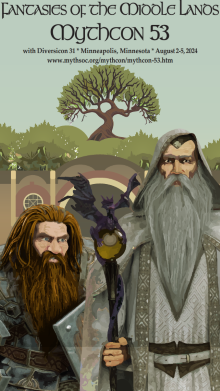Loading...
Event Website
Start Date
2-5-2022 3:30 PM
Description
In the 1130s, Geoffrey of Monmouth originated the character of Merlin, setting him upon the world stage as a wonder-working youth fathered (in the tradition of Greek and Latin authors of the past) by a daemon. However, later writers of the Middle Ages, beginning with Robert de Boron, reconceived Merlin within a more Christianized world, altering his heritage and transforming his sire into a demon from Hell. This shift from benign daemon to malevolent demon has impacted the representation of the wizard of Camelot for centuries. Contemporary fiction for the page as well as for the screen has adopted and adapted these two versions of Merlin’s origins in unique ways that remain largely unexplored by enthusiasts of the Matter of Britain. This presentation will build upon my previous research and highlight how both the Galfridian and Boronic traditions remain alive in depictions of Merlin in modern fantasy film and television produced for children and young adults. My focus will be in mapping out the strategies for the ways Merlin’s parentage has been received, packaged (alternately ignored, alluded to, altered, or accepted and embraced), and disseminated to audiences.
Creative Commons License

This work is licensed under a Creative Commons Attribution-NonCommercial-No Derivative Works 4.0 International License.
Included in
Children's and Young Adult Literature Commons, Comparative Literature Commons, Digital Humanities Commons, European Languages and Societies Commons, Literature in English, Anglophone outside British Isles and North America Commons, Literature in English, British Isles Commons, Literature in English, North America, Ethnic and Cultural Minority Commons, Medieval Studies Commons, Modern Languages Commons, Modern Literature Commons, Other English Language and Literature Commons
Who’s His Daddy? Approaches to Merlin’s Father in Children’s and YA Media
In the 1130s, Geoffrey of Monmouth originated the character of Merlin, setting him upon the world stage as a wonder-working youth fathered (in the tradition of Greek and Latin authors of the past) by a daemon. However, later writers of the Middle Ages, beginning with Robert de Boron, reconceived Merlin within a more Christianized world, altering his heritage and transforming his sire into a demon from Hell. This shift from benign daemon to malevolent demon has impacted the representation of the wizard of Camelot for centuries. Contemporary fiction for the page as well as for the screen has adopted and adapted these two versions of Merlin’s origins in unique ways that remain largely unexplored by enthusiasts of the Matter of Britain. This presentation will build upon my previous research and highlight how both the Galfridian and Boronic traditions remain alive in depictions of Merlin in modern fantasy film and television produced for children and young adults. My focus will be in mapping out the strategies for the ways Merlin’s parentage has been received, packaged (alternately ignored, alluded to, altered, or accepted and embraced), and disseminated to audiences.



Comments
Host: Nolan Meditz
Tech Mod: Alicia Fox Lenz
Michael Torregrossa is a graduate of the Medieval Studies program at the University of Connecticut (Storrs) and works as an adjunct instructor in English in both Rhode Island and Massachusetts. His research focuses on the adaption of Arthuriana in popular culture. Michael’s previous work on Merlin appears in Film & History, The 1999 Film & History CD-ROM Annual, and The Medieval Hero on Screen: Representations from Beowulf to Buffy.